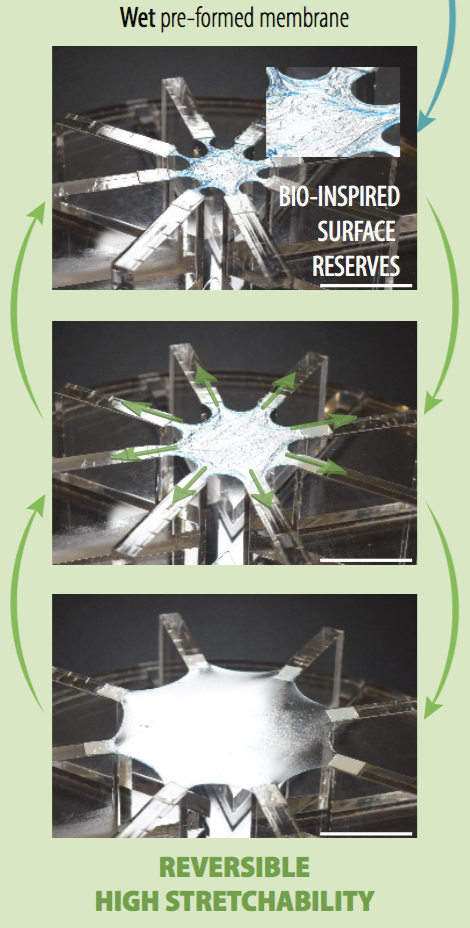Bonjour à tous,
j’ai le plaisir de vous inviter à ma soutenance de thèse qui aura lieu le vendredi 9 février à 14h en salle Paul Germain salle 401, 4ème étage, barre 55/65, Campus UPMC, 4 place jussieu, Paris 5ème.
J’y présenterai mes travaux intitulés :
Le flambage élasto-capillaire de fibres et de membranes fibreuses fines pour la conception de matériaux étirables
devant le jury composé de :
José BICO Rapporteur PMMH – ESPCI
Dominic VELLA Rapporteur Mathematical Institute – Université d’Oxford
Davide BIGONI Examinateur SSMG – Université de Trento
Yves BRECHET Examinateur SIMAP – INP Grenoble
Jean-Jacques MARIGO Examinateur LMS – Ecole Polytechnique
Régis WUNENBURGER Examinateur ∂’Alembert – Sorbonne Université
Natacha KRINS Invitée LCMCP – Sorbonne Université
Arnaud ANTKOWIAK Co-directeur de thèse ∂’Alembert – Sorbonne Université
Sébastien NEUKIRCH Co-directeur de thèse ∂’Alembert – CRNS
Je serai heureux de vous retrouver au pot d’après-soutenance qui se déroulera par la suite dans la même salle.
Paul Grandgeorge
http://www.ida.upmc.fr/~grandgeorge/

________________________________________________________________________________________________
Le flambage élasto-capillaire de fibres et de membranes fibreuses fines pour la conception de matériaux étirables
Résumé : Cette thèse porte sur les interactions mécaniques entre liquides et structures élastiques fines. Dans un premier temps, on s’intéresse à une goutte liquide posée sur une fibre horizontale indéformable. L’influence de la tension de surface et de la gravité sont révélées par une étude numérique et analytique du système. Cette compréhension nous permet d’introduire un outil de mesure de rayon de fibre précis, validé expérimentalement sur des fibres microniques. Mais les forces capillaires développées par les gouttes peuvent être suffisantes pour déformer de fines fibres élastiques. Par exemple, lorsqu’elle est comprimée, une fibre de soie de capture d’araignée flambe et s’enroule au sein des gouttes d’eau qui la décorent naturellement. Cet enroulement élasto-capillaire octroie une extensibilité apparente remarquable à la fibre composite qui s’enroule et se déroule spontanément, assurant ainsi la tension du système au gré des déformations imposées. Ce comportement mécanique peut revêtir un intérêt particulier pour les connecteurs électroniques étirables mais la rigidité de fibres métalliques compromet l’enroulement élasto-capillaire. Cet obstacle est surmonté en apposant une fibre d’élastomère souple à la fibre fonctionnelle. Cette stratégie de la fibre auxiliaire souple facilite l’enroulement en renforçant les forces capillaires sans pour autant augmenter significativement la rigidité à la flexion globale de la fibre composite. Dans le cas de la goutte sur fibre simple, la dynamique d’enroulement et de déroulement est étudiée, et introduit une expérience originale pour l’étude de la dynamique de la ligne de contact.
L’élasto-capillarité assure une étirabilité unidimensionnelle aux fibres élastiques fines présentées. Cette stratégie est étendue aux structures bidimensionnelles en imbibant une fine membrane fibreuse d’un liquide mouillant. Lorsque les bords de cette membrane imbibée sont rapprochés, la membrane solide se plisse au sein du film liquide et reste ainsi globalement droite. L’étude expérimentale et théorique de ce matériau hybride liquide-solide révèle un comportement à la fois solide et liquide : le film liquide apporte une tension de surface tandis que la membrane fibreuse solide assure l’inextensibilité. Finalement, le motif de flambage dessiné par la membrane imbibée lorsqu’elle est comprimée est analysé et interprété par un modèle théorique.
_______________________________________________________________________________________________________
Surface-tension induced buckling of thin fibers and fibrous membranes: a novel strategy to design stretchable materials
Abstract:
This PhD thesis focuses on the mechanical interactions between liquids and thin elastic structures. First, we study the mechanics of a liquid drop sitting on an undeformable horizontal fiber. We numerically and analytically investigate how capillarity and gravity affect the shape of the drop and the forces it develops on the fiber. This understanding allows us to introduce a precise fiber-radius measurement technique, experimentally validated on micronic fibers. But capillary forces developed by drops are sometimes strong enough to deform thin elastic fibers. For example, upon compression of its ends, a spider capture silk fiber spontaneously buckles and spools inside water droplets naturally sitting on it. This elasto-capillary coiling provides the composite system with an apparent extreme extensibility as excess fiber is continuously spooled in or out of the liquid drop, thus ensuring tension throughout large deformations. This mechanical behavior could be of interest for stretchable electronic connectors but the stiffness of metallic fibers jeopardizes in-drop coiling. We overcome this limitation by attaching a beam of soft elastomer to the functional fiber. This soft auxiliary beam strategy favors coiling by enhancing capillary forces without significantly increasing the overall elastic bending rigidity of the composite fiber. We also study the coiling and uncoiling dynamics of the drop-on-a-single-fiber compound, presenting a novel experiment for the study of contact line dynamics.
Elasto-capillarity with thin elastic fibers provides one-dimensional stretchability. This strategy is generalized to two-dimensional structures by infusing a thin free-standing fibrous membrane with a wetting liquid. When the boundaries of this wicked membrane are brought closer, the solid membrane wrinkles and folds inside the liquid film, and therefore remains globally flat. We experimentally and theoretically study the mechanical behavior of this hybrid liquid-solid material whose main feature lies in a mixed liquid-solid behavior: the liquid film provides surface tension while the solid fibrous membrane provides inextensibility. Finally, we analyze the buckling pattern displayed by the wicked membrane upon compression and propose a theoretical model recovering the main experimental features.
_______________________________________________________________________________________________________

 CISM International Centre for Mechanical Sciences
CISM International Centre for Mechanical Sciences